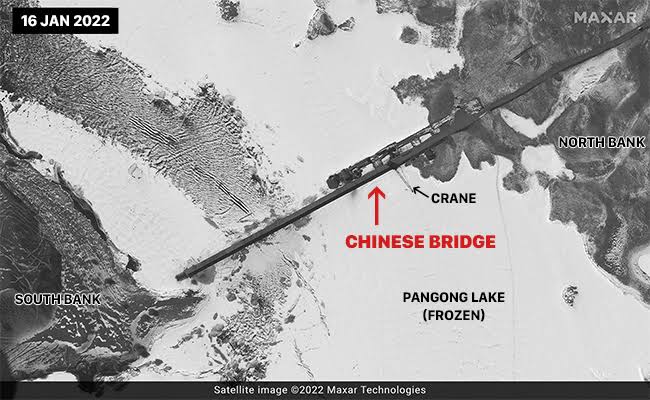China has nearly completed the construction of a bridge in the region of Pangong Tso lake, and India claims it to be illegal. The bridge is 400 meters long and 8 meters wide and it is near to the friction points in the northern region of the lake. The bridge is near the halfway mark on Pangong Tso.
Previously troops and tanks faced each other just a few 100 meters apart in border regions and friction points. This disengagement of troops took place in February 2021. After that the Galwan clash took place which led to a lot of casualties on both sides. After that incident Indian troops have managed to capture the Kailash range which gives tactical and height advantage to counteract chinese troops in Pangong region.
Indian troops camped at regions of Magar hill, Rezen la, Rechin la, and have an upper hand in Spanggur gap which can be used to be in an offensive advantage.
How does the Bridge help them?
According to the security established sources, the terrain of the Kailash region is difficult to mobilize through, so the latest bridge will help them get their troops as fast as possible in that region.
It looks like their main aim is to mobilize troops faster to the conflict points and maintain the upper hand always through this bridge.
According to the experts ” the construction of this bridge hence appears to be a lesson learned by PLA planners looking to provide seamless connectivity and rapid mobility for the elements responding in the future, to the frontline with India”.
How did India respond?
External affairs ministry spokesperson Arindam Bagchi stated that the ” government has been monitoring the bridge activity closely”.
“This bridge is being constructed in areas that have been under the illegal occupation of China for around 60 years now”.
He also said “the government has been taking all necessary steps to ensure that our security interests are fully protected” and as a part of these efforts, the budget for border infrastructure development has been allocated more relatively.
“Like China, India too is upgrading and developing infrastructure along the northern border in a holistic manner” including roads, tunnels, all-weather connectivity, strategic railway lines, additional bridges, and storage facilities”, stated Army chief general M.M Naravane.
Additionally, India has sent 25000 more troops to that area for backup.
“Because of all that we have done, I think we are in a much better position than where we were a year and a half ago, and also much better prepared to meet any challenge that is thrown up in the future”, he said.
In addition, over 100 projects in 2021 were completed by the border roads organization in the border areas, which are nearer to the border of China.
Current Situation
Most of the friction points have been resolved as both sides agreed to de-escalate their troops from patrolling point(PP) in Galwan valley and banks of Pangong lake and PP17A near Gogra post. In the recent meeting, there was an unresolved agreement between military officials of both countries and talks have been struck since july.

